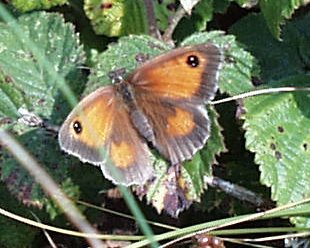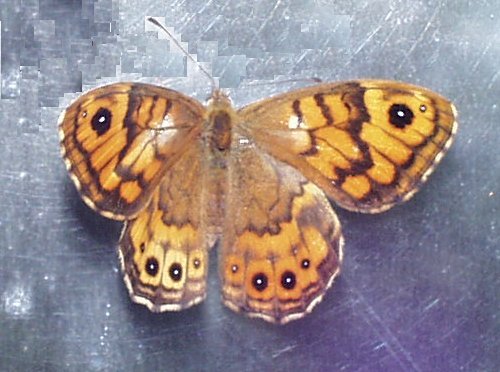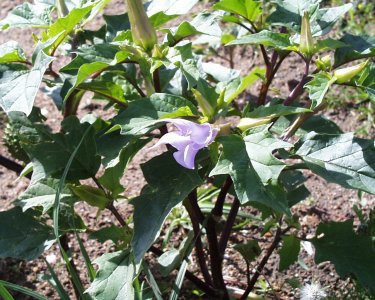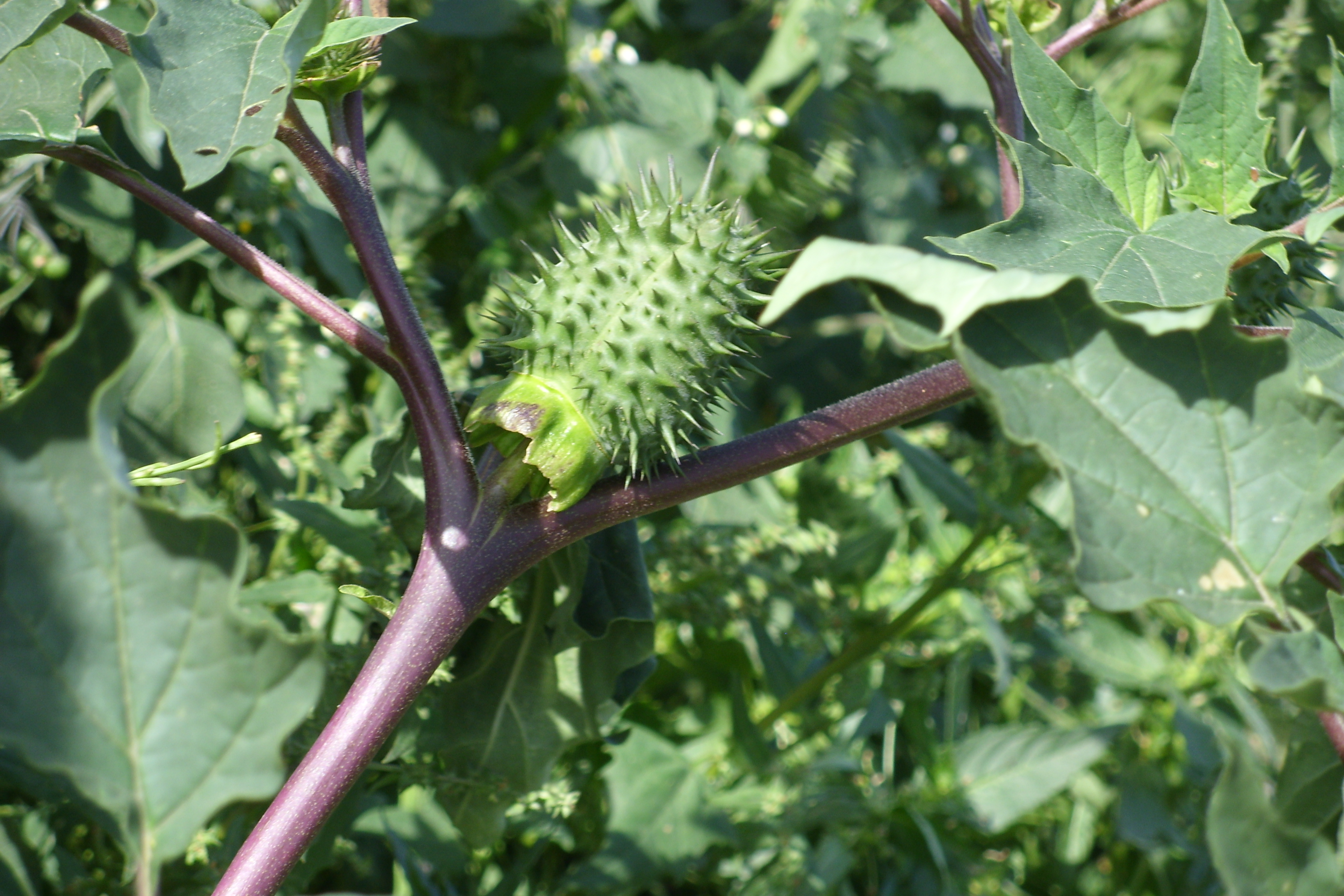 A Grey Heron was fishing in the rapidly drying up Mannez pond. Note the difference from the very common Wall Butterfly (photo on left).
A Grey Heron was fishing in the rapidly drying up Mannez pond. Note the difference from the very common Wall Butterfly (photo on left).
Alderney Nature Diary
August 2001
The Weather
Rainfall was well above average and almost eight times that of last August. About half of the total fell on just two days. Rain persisted all day on 7th and, on 26th, 13mm rain fell in 25 minutes with thunder & lightning 12.45-13.15. During this, the wind went through 180º and went calm, then back again when it stopped. Total for the year to date is almost 200mm above both last year and the long term average.
Fog or thick mist was present on several mornings and evenings, persisted almost all day on one day and surrounded the island just offshore on several days. Despite the generally warm temperatures, brief hail storms occurred on three days. There were no days without at least half an hour's sunshine, but the total was still 14 hours below average and 37 hours less than last year. The total for the year so far was however over 100 hours up on last year and 86 hours above average.
Temperatures, barometric pressure and wind speeds and direction, were all generally about average, but the month was characterised by unusually warm nights and high humidity.
Figures for comparison with August last year and the 20-year average
| Year | 2001 | 2000 | 20-year average |
| 1981-2000 | |||
| Rain mm. | 63.5 | 8.8 | 39.4 |
| Sun hrs. | 215 | 251.8 | 229.4 |
| Max. temp recorded °C | 23.9 | 23.0 | 23.4 |
| Min. temp recorded | 14.1 | 11.4 | 11.2 |
| Mean day temp | 18.8 | 18.7 | 19.3 |
| Mean night temp | 17.0 | 16.8 | 14.5 |
| Total rainfall, year to date, mm. | 581.7 | 389.3 | 398.2 |
| Total sunshine, year to date, hrs. | 1485.4 | 1370.8 | 1399.1 |
The Diary
1st. August. An enormous quantity of Golden Samphire (Inula crithmoides), on the low cliff between Arch Bay and Château à L'Étoc. Interspersed with a large number of the much more common Rock Samphire (Crithmum maritimum), both in flower. This is the first time I have seen Golden Samphire at this point, but I rarely walk along the little track right on the edge of this short section and the quantity suggests it must have been there for a long time.
Red Admirals, Blues and literally hundreds of Gatekeeper Butterflies just across the road in Mannez quarry. There seem to be two different sizes of the latter although both have the two white spots in the black circle on their wings and otherwise appear identical. Hawkweed Oxtongue (Picris hieracoides), is plentiful here, it might be the var. incana nana, known as Druce's Oxtongue which I have found regularly around nearby Fort Corblets, but I did not take a specimen to be sure. Hoary Mustard (Hirschfeldia incana), plants up to 2m high are plentiful, with Common Fleabane (Pulicaria dysenterica), Water Mint (Mentha aquatica), and Great Willowherb (Epilobium hirsutum), all in some quantity around the SW edge of the pond. There was no sign of the Water Crowfoot (Ranunculus tricophyllus), which has been at this spot for many years. New Zealand Water-weed (Crassula hlemsii), has spread considerably and there was a huge expanse, 80-50m of this, mixed with about an equal quantity of Parrot's Feathers (Myriophyllum aquaticum), spreading across the almost whole dried up area. The Lesser Bulrush (Typha angustifolia), has also colonised large areas here in the last 3-4years. The original area, the clearing of a large part of which I organised about 10 years ago, when the pond dried completely and most of it was removed with the rooting system and much of the silt, has now spread to its former size, but there are now several additional areas, the principal of which has come from the heap of vegetation, left piled up against the back of the quarry wall, when it should all have been removed and burnt as was instructed. A new clearance has now been arranged, but is scheduled to take place whilst I am away. This will also remove most of the other two mentioned and a considerable area of Amphibious Bistort (Polygonum amphibium), in flower, which has also spread recently.
At the edge of the dried part of the pond several patches of Greater Bird's-foot-trefoil (Lotus pedunculatus), were flowering amongst the brambles. Three seedlings (or more likely planted suckers, the nearest possible parents being a very considerable distance away), of White Poplar (Populus alba), were growing in what would normally be the edge of the water. Can't imagine why anyone should be daft enough to plant them here though.
Interestingly, in the remaining area of open water at the deeper eastern end, I found a considerable amount of Small Pondweed (Potamogeton berchtoldii), floating. This has only been recorded from Corblets quarry pond previously. Hundreds of Swallows were 'hawking' for insects over the water area.
In The Cut, near the harbour, two different sorts of 'Everlasting Pea' were in flower on the lower part of the almost vertical cliff. Probably Lathyrus latifolius, first recorded last year, as well as the L. grandiflorus which I have noted here for several years.
2nd August. A mass of Gatekeeper Butterflies (photo on right) along the track up to "The Odeon". This species has only recently been recorded in Alderney.
 A Grey Heron was fishing in the rapidly drying up Mannez pond. Note the difference from the very common Wall Butterfly (photo on left).
A Grey Heron was fishing in the rapidly drying up Mannez pond. Note the difference from the very common Wall Butterfly (photo on left).
3
 rd. August. A tremendous gathering of Gannets circling over and nesting on Les Etacs. This year many more pairs have colonised several of the small stacks nearer Alderney than just on the main rock and the next largest. Heather (Calluna vulgaris), Bell-Heather (Erica cinerea), and Tormentil (Potentilla erecta), flowering in quantity over the grassy Giffoine headland. Thrift (Armeria maritima), was pretty well finished, with the flower heads all turning into dried white balls. Fulmars circling around the tiny bay to the NE. I counted about 30 occupied nests on this piece of cliff.
rd. August. A tremendous gathering of Gannets circling over and nesting on Les Etacs. This year many more pairs have colonised several of the small stacks nearer Alderney than just on the main rock and the next largest. Heather (Calluna vulgaris), Bell-Heather (Erica cinerea), and Tormentil (Potentilla erecta), flowering in quantity over the grassy Giffoine headland. Thrift (Armeria maritima), was pretty well finished, with the flower heads all turning into dried white balls. Fulmars circling around the tiny bay to the NE. I counted about 30 occupied nests on this piece of cliff.
6th August. Rowan (Sorbus aucuparia), berries already quite a bright orange-red and Hawthorn (Crataegus monogyna), berries beginning to show colour. The Burnet Rose (Rosa pipmpinellifpolia), appears to have finally gone from the site of the wall of the cliff road at Val du Saoue, smothered by Ivy and overshadowed by large Elaeagnus 'trees'. Up to 14 Grey Atlantic Seals seen today on the reefs at the back of Burhou.
10th August. Gatekeepers and Painted Ladies numerous in Mannez quarry and dozens of Emperor Dragonflies and a few Blue Demoisellles.
12th August. Masses more Gatekeepers on Mannez Garenne, with a number of Red Admirals and a lot of Blue butterflies. Ground very dry and bracken beginning to turn. A quantity of Bastard Toadflax (Thesium humifusum), as usual, but conspicuous now by its olive colour as it dries up, on the short grassy turf along the track down to Sharp's Farm. Thyme and Rest-harrow flowering still. A second flowering both here and on Fort Albert Hill of the Viper's Buglos, (Echium vulgaris). The view across The Race to France is so clear today you can practically see people on the beaches with the naked eye. More Gatekeepers and a tatty-looking Red Admiral on Platte Saline. More Gatekeepers and a Green Damselfly in my garden nearby. Jersey Tiger Moths have been occasional throughout the month
13th August. Several dozen 'Compass plants', (Prickly Lettuce Lactuca serriola), on the banks up La Vallée and more in Le Petit Val.
14th August. Thick fog over the island first thing. Burnt off at around 11am as the sun heated up, leaving dense mist all round the island, all day, just offshore by a few dozen metres. Artichokes (Cynara scolymus), and Teasels (Dipsacus fullonum), in flower on a bit of waste ground at La Marette.
20th August. Swallows beginning to line up on the electricity wires in Le Grand Val, they'll be departing soon. A new species of Angel's Trumpets has appeared, this one appears to be Datura stramonium var. tatula, (Photo on left), about 20 plants in a small area of recently spread soil at the
 Railway Station. An annual about 30-40 cms high with big gree
Railway Station. An annual about 30-40 cms high with big gree
 n shiny seed pods (Photo on right), with many spines and pale blue and white flowers about 10cm long. A few days later Margaret Long, the Jersey botanist, independently identified this as the species I had already run down in the RHS Dictionary. The soil came from St. Catherine's House in Victoria Street. The owners are sure they have never seen this plant in their garden in the 20 years or so they have been there. In common with many other Solanaceae, the seed has probably been long dormant in the soil and only germinated after it had been disturbed.
n shiny seed pods (Photo on right), with many spines and pale blue and white flowers about 10cm long. A few days later Margaret Long, the Jersey botanist, independently identified this as the species I had already run down in the RHS Dictionary. The soil came from St. Catherine's House in Victoria Street. The owners are sure they have never seen this plant in their garden in the 20 years or so they have been there. In common with many other Solanaceae, the seed has probably been long dormant in the soil and only germinated after it had been disturbed.
The berries on the Italian Arum (Arum italicum), spikes, now standing tall are beginning to turn red.
 The recent dry spell, wind and comparatively hot sun has run the water level in Corblets quarry down at least two feet over its high level noted last month. More Emperor Dragonflies and a lot of different butterflies with many Gatekeepers and small numbers of Walls and Blues, (both with mating pairs in evidence), including a few Whites along the East Coast. Thousands of Autumn Squills (Scilla autumnalis) (Photo on left), flowering on the headland in front of "Tides", with smaller numbers on Mannez Garenne and amongst the bracken on the field belong to "Blanchard". The Squills were being patronised for their nectar by a large number of small nearly all-black bumblebees, mostly with a pale or orangey 'bottom'. One or two plants had white flowers. Hundreds of them about here and on the Bell-heather nearby. The single plant of Myrtle on this headland has grown considerably and there are three seedlings about 1m away. Very few Rabbits seen this year in the meadow beside "Tides" and no black ones noted.
The recent dry spell, wind and comparatively hot sun has run the water level in Corblets quarry down at least two feet over its high level noted last month. More Emperor Dragonflies and a lot of different butterflies with many Gatekeepers and small numbers of Walls and Blues, (both with mating pairs in evidence), including a few Whites along the East Coast. Thousands of Autumn Squills (Scilla autumnalis) (Photo on left), flowering on the headland in front of "Tides", with smaller numbers on Mannez Garenne and amongst the bracken on the field belong to "Blanchard". The Squills were being patronised for their nectar by a large number of small nearly all-black bumblebees, mostly with a pale or orangey 'bottom'. One or two plants had white flowers. Hundreds of them about here and on the Bell-heather nearby. The single plant of Myrtle on this headland has grown considerably and there are three seedlings about 1m away. Very few Rabbits seen this year in the meadow beside "Tides" and no black ones noted.
25th August. Hawthorn Berries nearly all red now. 4pm. Nearly low tide. Two Little Egrets and a Grey Heron amongst the rocks at Tourgis Point. Further along towards Fort Clonque at Blue Bridge, nine more Little Egrets were observed about 4.30. On the way back along the track a careful eye was kept on their movements. none flew from this bunch, but four more were seen opposite the cottages and another three by the car parking area about 4.45. Two of these had probably flown in from Tourgis Point around the corner, as they had gone from there and only the Heron remained. This means that there was probably a total of 16 in the area at the same time. An unusually high number.
26th August. As recorded at the start of this report, a very heavy thunderstorm at lunch time.
27th August. Lots of Wheatears down by Kiln Farm. The Autumn migration has started, the nights are definitely drawing in. Dark by about 6-6.30 and the days are getting cooler.
For the second month, I append the full daily weather record chart.
